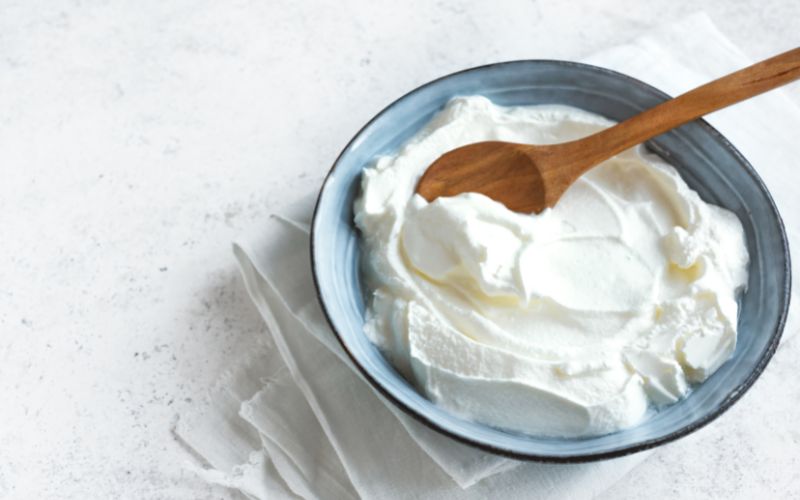Is Greek Yogurt Supposed To Be Chunky? (Must Read)
Last updated on October 26th, 2022 at 05:18 pm
Greek yogurt is a trending dairy product consumed in many parts of the world.
This dessert has a unique thick creamy texture, unlike others of the same kind.
For this reason, you might wonder if it’s normal for the famous Greek yogurt to be chunky. If that’s the case, keep reading to find out!
Greek yogurt shouldn’t contain small balls or chunks. But if it does, the dairy product has curdled, changing its texture. Usually, this happens when yogurt sits for long in the fridge, Greek yogurt should be smooth, dense, and creamy.
Is Greek Yogurt Supposed To Be Watery or Chunky?

Normally, Greek yogurt shouldn’t be watery or Chunky. Folks love this dairy product for its thick and creamy texture.
Seeing liquid on the top of the yogurt or feeling it’s unusually bulky while stirring means it has curdled.
Generally, Greek yogurt is chunkier than regular yogurt because it contains less water.
As earlier, Greek yogurt should be smooth and soft but thicker than regular yogurt and creamy.
The product becomes runny and chunky when whey separates from the mixture.
This watery whey is a natural protein found in dairy products and is safe to eat. But when the whey stays on the product’s surface, it becomes watery.
Furthermore, more liquid may gather on the surface of the Greek yogurt the longer it sits in the fridge.
While the top becomes thin and watery, the whey separation makes the yogurt chunky or thick at the bottom.
However, it’s okay to feel chunks in Greek yogurt due to curdling. Shaking or stirring up the whey and chunk brings back your yogurt’s creamy texture.
Is Chunky Greek Yogurt Good To Eat?
Chunky yogurt is fine to eat if the chunkiness results from curdling. However, an awful smell or noticeably bad texture means the dairy product is spoiled.
On the other hand, yogurt can curdle when it stays in the fridge for a long time. Also, yogurt can curdle at a high temperature while cooking.
So, if the product seems thicker than usual, stir the product, and it’ll return to normal.
Similarly, you can add a little liquid to your Greek yogurt if it’s almost solid rather than creamy.
Usually, chunks or small balls will rest at the bottom of the Greek yogurt container. But mind you, mold can take a tiny round appearance too.
Therefore, take a good look at the product to know whether it’s just curdling or mold buildup.
In addition, Greek yogurt gets very chunky when curdled because it’s more strained than normal yogurt.
You can use the chunky Greek dairy product to dress your chicken salads. Also, curdled yogurt can add flavor to tacos.
Why Is My Greek Yogurt Lumpy?
Usually, over-culturing Greek yogurt can cause it to become lumpy, making it look like cottage cheese.
Simply fermenting the dairy product for too long or at a high temperature can give it an unappealing texture.
Further, using a compromised starter culture while culturing yogurt causes it to separate or turn lumpy.
Also, curdling can cause your Greek yogurt to become lumpy or create small balls inside the product.
However, bad yogurt can also be lumpy or separate from each other. So, if Greek yogurt becomes lumpy while culturing, you can correct it and enjoy it.
The same thing goes for when the product becomes lumpy because of curdling.
But, if the lumpiness of your yogurt isn’t due to any of the above reasons, then it’s spoiled.
How Do I Know if Greek Yogurt Has Gone Bad?
Greek yogurt goes bad when the expiration date on the dairy product is due.
However, the product can stay good two weeks past its sell-by date, depending on how you keep it.
That’s said, let’s look at more ways to tell if your yogurt has spoiled.
#1. Excess Water on the Surface
It’s normal to find some liquid on top of your yogurt. This substance is “whey,” This liquid is not always a sign that your yogurt is spoiled.
In some cases, this nutrient-packed substance appears when the yogurt curdles. In this situation, you can stir the product and enjoy it as usual.
On the other hand, your Greek yogurt might have gone bad when there’s an excess amount of liquid on the surface.
When you notice this event, it indicates that the product is spoiled, and it’s time to toss it.
#2. Change in Texture
It’s a bad sign if the texture of the entire product shows a very noticeable change.
Unless curdled or thawed, the whole yogurt shouldn’t take another form different from how you purchased it.
If you whirl the watery yogurt and it doesn’t return to its original state, it’s spoiled.
Yogurts that have gone bad might lose their viscosity and creamy consistency.
As a result of this action, the dairy product will turn watery or runny. Also, it’s a bad sign if yogurt becomes lumpy.
The product has to be thrown away after whirling it, and the yogurt remains the same.
The product’s consistency will often feel like cottage cheese, and that texture isn’t right.
#3. Bad Smell
You can sniff and detect whether the yogurt is spoiled or still good for consumption. The sense of smell is one reliable way to tell if food has gone bad.
The nose is sensitive to foul and stinky smells. So if you have any doubts about the yogurt, trust your instincts and throw it away.
#4. Signs of Mold
If mold starts appearing on the yogurt, it is a sign that the product isn’t safe to eat. You can’t cut corners when mold appears on your food.
This statement is because the molding process started earlier before you noticed it.
For this reason, the whole yogurt had gone bad before the mold became visible.
Therefore, scooping out the moldy part doesn’t make the remaining edible. Never do this trick because you might be putting your health on the line.
So, if you see or notice mold in your yogurt, it’s better to discard the whole thing.
#5. Bloated Packaging
Yogurt packages, like any other product container, will start swelling if there’s bacteria growth.
This problem happens as the dairy product ferments and begins to release gas, making the container bulge.
When you see the lid of the yogurt pop off while opening the product, it’s a warning sign. The bloating indicates that the yogurt has gone bad and isn’t good to eat.
#6. The Taste
When you don’t see any of these signs, you should taste a bit of the product and see for yourself.
If the yogurt is too sour or makes you frown, it’s time to let go. This option is the fastest way to clear your mind about the state of the yogurt.
Is Greek Yogurt Healthy?
Greek yogurt is quite healthy. Eating yogurt every day supplies the GI tract with healthy bacteria.
Similarly, Greek yogurt is rich in probiotics to help improve your immune and digestive health.
This action is possible because the good bacteria from yogurt prevents ‘bad’ bacteria from taking over your GI tract.
In addition, strained yogurt is lower in sugar and higher in protein than regular yogurt.
Also, Greek yogurt promotes weight loss, as it’s high in protein and low in sugar, fat, carbs, and calories.
According to the USDA, a container or 156g serving of Greek yogurt boasts the following nutritional facts.
| Constituents | Amounts |
|---|---|
| Calories | 92 |
| Fats | 0.265g |
| Potassium | 220mg |
| Carbohydrate | 5.68g |
| Sugar | 5.1g |
| Protein | 16.1g |
| Calcium | 111mg |
As much as Greek yogurt is healthy, it also has some downsides. The problem is that dairy products contain natural hormones, which can harm the skin.
Especially if you have a hormonal imbalance, the pasteurized and homogenized milk in the yogurt can cause histamine problems. These health issues include acne, eczema, and more.
Conclusion
Greek yogurt should be smooth and dense while still being creamy without any presence of chunks.
Usually, the dairy product becomes chunky and watery on the surface when it has curdled or gone bad.
You can fix this complication by running water off the yogurt’s surface and whisking it.







